In this article, we will identify the key components of an effective onboarding strategy and examine various onboarding process examples that can be tailored to meet the unique needs of your organization
Onboarding Process Examples
A successful onboarding experience helps new hires feel supported, confident and connected from day one.
A well-structured process improves employee satisfaction, reduces turnover and strengthens long-term productivity.
To design an effective program, organizations can focus on three key areas:
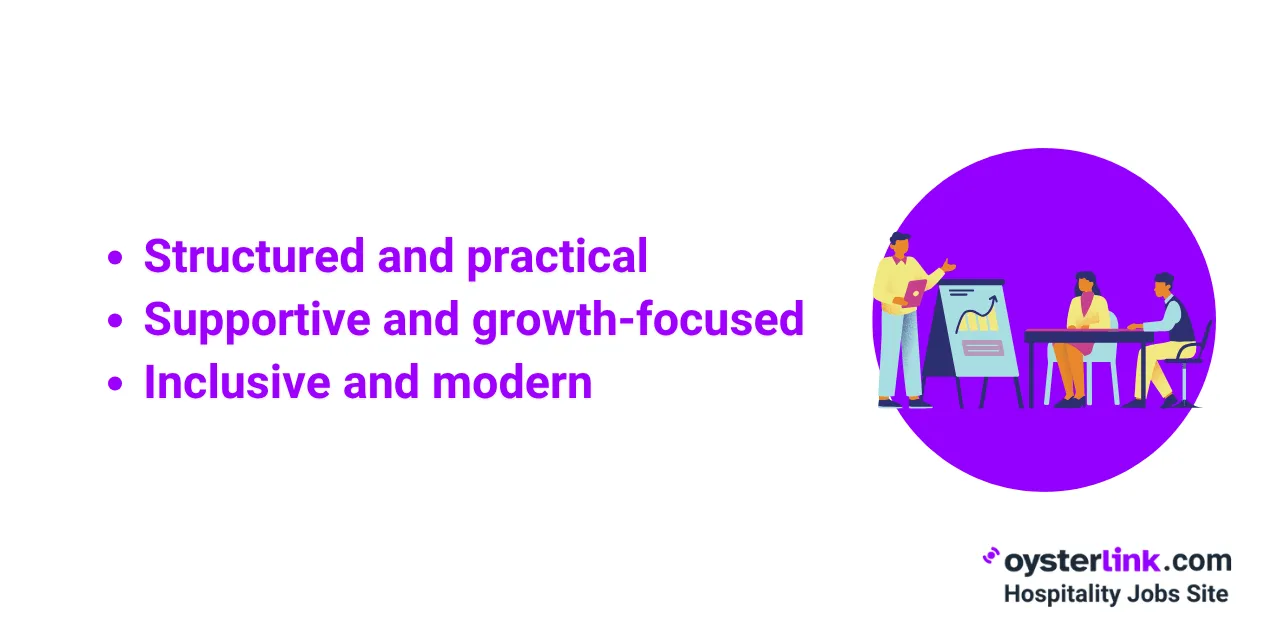
- Structured and practical onboarding process examples that ensure clarity, organization and a smooth transition.
- Supportive and growth-focused onboarding process examples that build relationships, mentorship and personal development.
- Inclusive and modern onboarding process examples that embrace technology, diversity and flexible work styles.
Each approach offers practical strategies that HR teams can tailor to fit their company’s culture and goals.
Structured and Practical Onboarding Process Examples
These examples focus on laying a strong foundation for new hires through organization, clarity and consistent communication during the onboarding process.
Example 1: Structured Onboarding Plans
Preboarding Activities
Before a new hire's official start date, organizations can engage them through preboarding activities. This phase includes:
- Welcome communication: A personalized welcome email from the hiring manager or HR can set a positive tone.
- Documentation: Sending necessary paperwork ahead of time can streamline the onboarding process and reduce first-day stress.
- Team introductions: Sharing information about team members and their roles help new hires feel connected before they start.
In this short video from First30 - For HR Pros!, you’ll learn how effective preboarding helps new hires feel confident and connected before their first day.
First Day Orientation
The first day is critical for making a lasting impression. Activities can include:
- Office tour: A guided tour of the workplace helps new hires familiarize themselves with the environment and locate essential facilities.
- Introductions to colleagues: Meeting team members and key stakeholders can help new hires build relationships early on.
- Overview of company culture: Discussing the company's mission, values, and culture is vital for aligning new hires with organizational goals.
A structured onboarding plan facilitates a smooth transition for new hires. The first three months are extremely vital since that’s when employees settle into their new environment.
This can be broken down into phases:
The First 30 Days
During the initial month, focus on:
- Role clarity: Clearly define job responsibilities and expectations to eliminate confusion.
- Training sessions: Provide training on tools, processes and systems relevant to the new hire's role.
- Regular check-ins: Schedule weekly meetings with the manager to discuss progress and address concerns.
The Next 30 Days
In the second month, emphasize:
- Integration into teams: Encourage participation in team meetings and collaborative projects to foster connections.
- Feedback mechanisms: Implement feedback loops where new hires can share their experiences and suggestions for improvement.
- Skill development: Offer opportunities for further training and skill enhancement relevant to their position.
The Final 30 Days
By the end of the first three months, ensure that new hires:
- Demonstrate competence: Assess their ability to perform their job effectively and independently.
- Engage with company culture: Encourage involvement in company events and initiatives to strengthen their sense of belonging.
- Set long-term goals: Collaborate on setting professional development goals that align with organizational objectives.
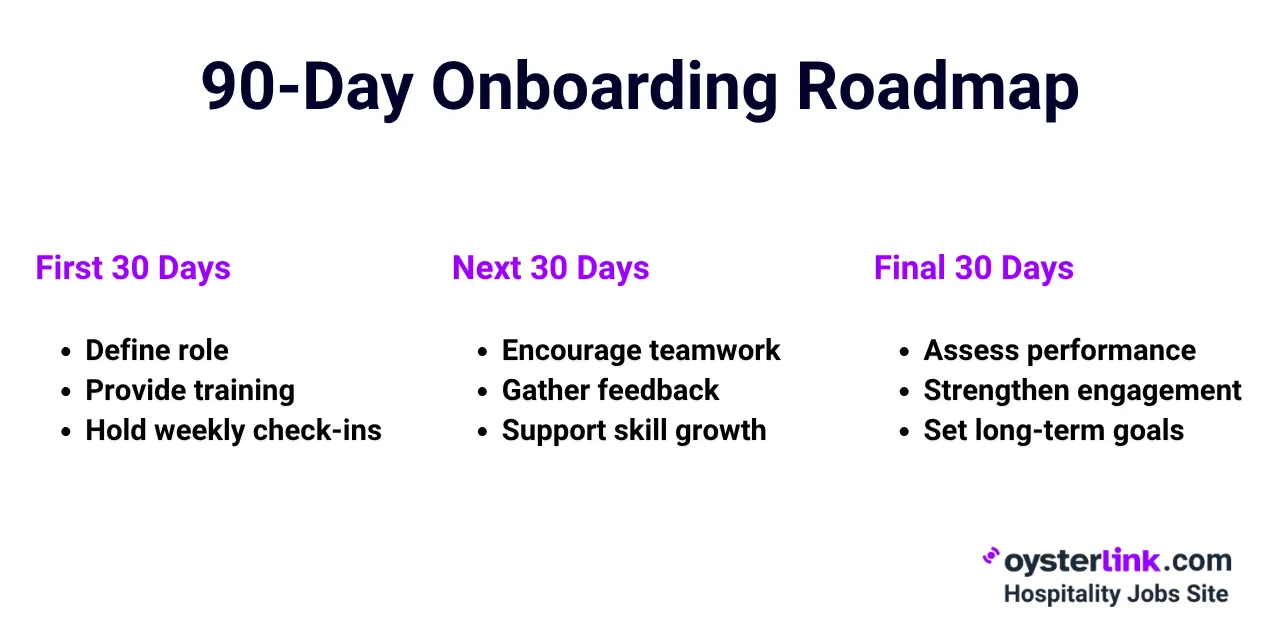
Example 2: Utilizing Technology in Onboarding
Leveraging technology can enhance the onboarding experience significantly. Here are some examples of how to implement tech solutions:
Onboarding Software
Investing in specialized onboarding software can automate various processes, such as:
- Document management: Streamline the collection and storage of necessary paperwork.
- Task management: Create checklists for onboarding tasks to ensure nothing is overlooked.
- Engagement tracking: Monitor new hires' progress and engagement levels through integrated feedback tools.
In this short video from HR Toolbox, you’ll discover five free onboarding software options that help small businesses streamline new hire management.
Virtual Onboarding Tools
For remote or hybrid teams, consider utilizing:
- Video conferencing platforms: Tools like Zoom or Microsoft Teams facilitate virtual meetings and training sessions.
- Interactive learning modules: Online training platforms can provide engaging learning experiences tailored to specific roles.
- Social collaboration tools: Platforms like Slack or Microsoft Teams promote informal communication and relationship building among team members.
Example 3: Creative Onboarding Activities
To make the onboarding experience enjoyable and memorable, consider incorporating creative activities:
Icebreaker Games
Starting with fun icebreaker activities eases tension and fosters connections. Examples include:
- Team trivia: A game where team members guess fun facts about each other.
- Virtual scavenger hunts: Engage remote employees in a fun search for items in their home workspace.
In this short video by AJ&Smart, Facilitation Coach Rebecca Courtney shares three effective icebreaker games that boost energy, creativity and teamwork during meetings or onboarding sessions.
Welcome Packages
Sending new hires a welcome package filled with company-branded merchandise can effectively communicate appreciation and make them feel valued as part of the team.
Consider including:
- Branded merchandise: Distribute mugs, t-shirts or notebooks that promote company spirit.
- Personalized notes: Handwritten notes from team members welcoming them to the organization.
Example 4: Continuous Feedback and Improvement
An ongoing feedback mechanism is essential for refining the onboarding process. This can be achieved through:
Surveys and Check-Ins
Regularly soliciting feedback from new hires can provide valuable insights.
Consider the following:
- Onboarding surveys: Conduct surveys after key milestones (e.g., after the first week, month and three months) to gather input on their experience.
- Manager feedback: Encourage managers to offer insights on how effectively new hires are integrating into their teams.
In this short video, leadership expert Heather R. Younger explains how to design impactful employee engagement surveys that uncover honest feedback and help improve workplace culture.
Example 5: Iterative Improvements
Use feedback to make continuous improvements to the onboarding process. This can include:
- Update training materials: Regularly revise training content based on new hire feedback and evolving company needs. This practice ensures that the training remains relevant and effective.
- Adjust onboarding plans: Tailor onboarding plans to address challenges new hires usually experience to help further streamline the onboarding process.
Supportive and Growth-Focused Onboarding Process Examples
This group highlights onboarding approaches that build relationships, promote learning and support long-term employee development.
Example 6: Establishing a Buddy System
A buddy system is essential for integrating new hires into the company by pairing them with experienced employees.
In this video, you’ll learn how companies like Microsoft use a buddy system to improve onboarding, increase retention and help new hires feel connected from day one. It also covers how to choose the right buddy and the long-term benefits for both employees and organizations.
Creating a buddy system where experienced employees guide new hires can provide:
- Support and guidance: Buddies can answer questions and offer insights into company culture.
- Social connections: Put a point of contact in place to help new hires feel more connected and less isolated.
Example 7: Structured Mentorship Programs
Implementing formal mentorship programs effectively facilitates professional growth and integration within a company.
Implementing formal mentorship programs can provide:
- Regular check-ins: Schedule meetings between mentors and new hires to discuss progress and challenges. These consistent interactions provide a structured opportunity for feedback and guidance.
- Skill development: Mentors can help new hires identify areas for growth and provide resources for skill enhancement. This targeted support ensures that new hires are well-equipped to meet their job requirements and career aspirations.
In this TikTok, a career expert explains how mentorship helps employees grow faster by offering real-world guidance and accountability — exactly the kind of support new hires need to thrive early in their careers.
Example 8: Customized Learning Paths
Role-specific training programs ensure that new hires get relevant information and skill training tailored to their particular job requirements.
- Develop personalized training sessions: Tailor training to the unique responsibilities of each role, focusing on critical skills and knowledge areas necessary for job success. This ensures that new hires receive relevant and effective instruction.
- Role-specific skill assessments: Begin the training with assessments to gauge the existing skills of new hires and identify areas for development. This initial evaluation allows training to be specifically targeted.
Example 9: Hands-on Projects
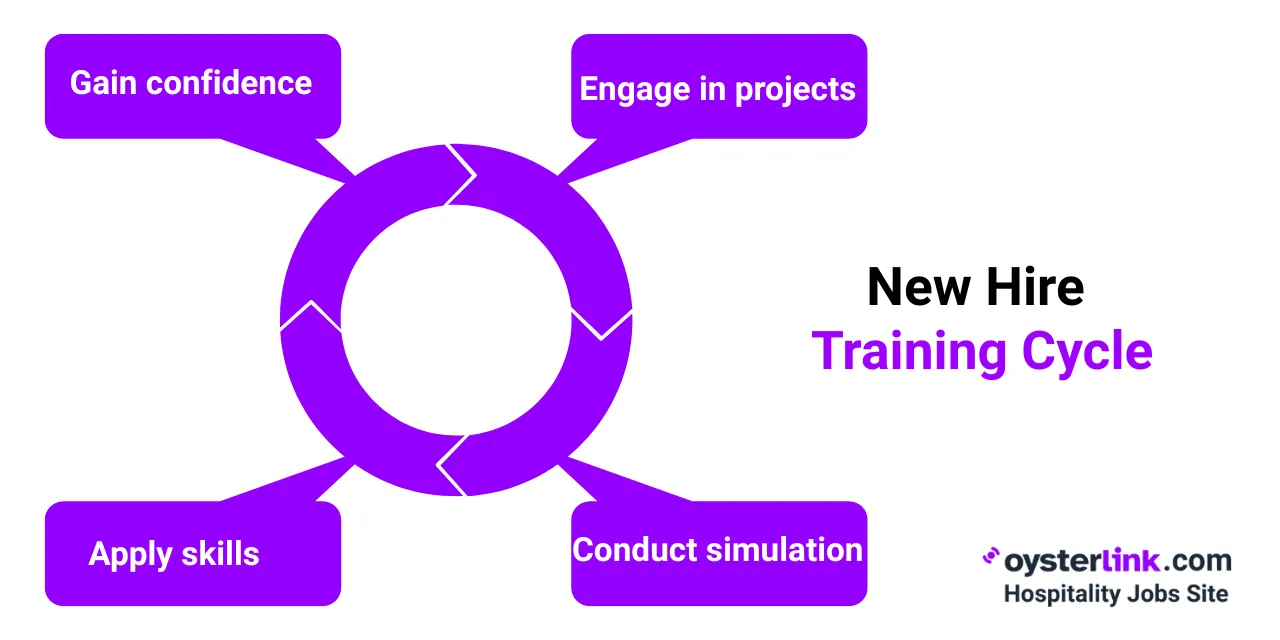
Engaging new hires in hands-on projects is crucial for bridging the gap between theoretical knowledge and practical application, fostering confidence and competence early in their careers.
- Engage new hires in ongoing projects: Involve new hires in ongoing projects or assign them starter projects to help them apply their newly acquired skills in real-world scenarios.
- Simulation exercises: Implement simulation-based training exercises that replicate real-world challenges within the company. These simulations provide a safe environment to practice problem-solving and decision-making, preparing new hires to handle actual tasks more effectively and with greater confidence.
Example 10: Mental Health Resources
Health and wellness initiatives within the onboarding process can set the stage for a supportive work environment from day one.
This short TikTok video highlights the importance of open mental health discussions in the workplace — a reminder that supporting employees’ well-being should start as early as onboarding.
- Offer access to counseling services: Support new hires' mental health by providing access to counseling services, stress management workshops, and seminars on work-life balance.
- Leverage wellness apps: Provide subscriptions to wellness apps that offer guided meditation and personalized mental health tracking.
Example 11: Fitness Programs
Promote a healthy work environment by providing gym memberships, fitness trackers or organizing virtual workout sessions.
This short video highlights how several companies are successfully integrating wellness and fitness programs into their workplaces — showing how even small initiatives can boost morale, teamwork and overall employee well-being.
- Organize group fitness classes: Encourage physical health and team bonding by offering group fitness classes, either onsite or through live-streamed sessions.
- Implement a bike-to-work program: Foster a healthy and eco-friendly commute by introducing a bike-to-work program. Provide incentives such as subsidized bike purchases, secure bike parking and access to shower facilities to encourage employees to participate and maintain an active lifestyle.
Inclusive and Modern Onboarding Process Examples
These examples show how modern organizations enhance engagement and inclusivity while adapting to diverse and remote work settings.
Example 12: Cultural Immersion Activities
Cultural immersion activities help new hires understand and integrate into the company's social and ethical fabric, enhancing their alignment with organizational values.
- Office traditions: Familiarize new hires with office traditions like annual picnics, holiday parties or unique Friday rituals. Doing so helps integrate them into the company culture, enhancing their sense of belonging and engagement with the team.
- Community engagement: Engage new hires in corporate social responsibility initiatives, such as community clean-ups or charity fundraisers. This participation fosters a sense of community and team cohesion.
Example 13: Technology Onboarding
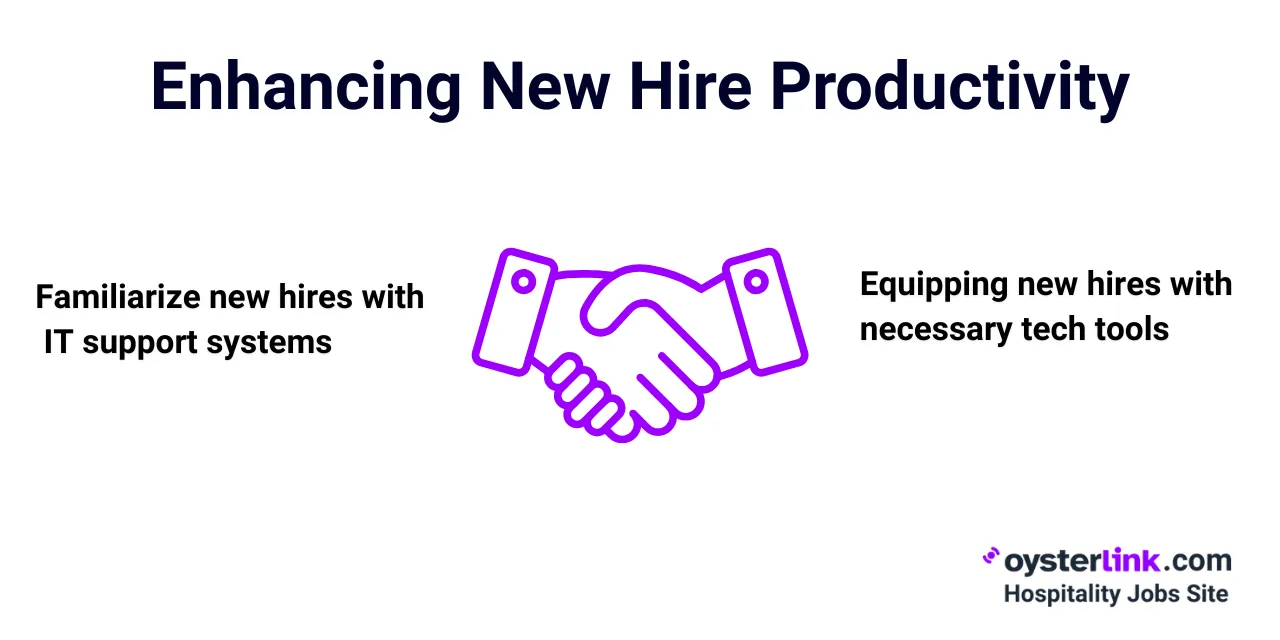
A comprehensive technology onboarding program equips new hires with essential tools and the knowledge to use these tools effectively, smoothing their transition into new roles.
- Provide comprehensive technology toolkits: Equip new hires with all necessary technology tools, from software to hardware and offer thorough training to minimize technical challenges that could hinder productivity.
- Introduce the IT support team: Ensure new hires meet the IT support team and familiarize themselves with the IT support systems. This familiarity helps them resolve potential technical issues quickly and reduce downtime.
Example 14: Inclusion Programs
Inclusion programs during the onboarding process educate new hires about diversity and equity and actively integrate them into the organizational culture.
- Conduct diversity workshops and seminars: Educate new hires about diversity, equity, and inclusion through workshops and seminars. These sessions aim to build awareness and foster an inclusive workplace culture.
- Promote participation in employee resource groups: Encourage new hires to actively participate in employee resource groups that match their interests or backgrounds. These groups provide valuable networking opportunities and support personal and professional development.
Example 15: 'Meet the Executives' Session
A 'Meet the Executives' session can significantly enhance new hires' perceptions of their onboarding experience.
Some tips to enhance the experience include:
- Preparation: Encourage new hires to prepare and submit questions or topics they are curious about beforehand to facilitate meaningful discussions.
- Sharing insights: Ask executives to share valuable lessons from their careers and personal stories, providing inspiration and deeper organizational insights.
- Social interaction: Include a relaxed activity, such as a coffee break or a shared lunch, to ease the atmosphere and foster informal interactions.
Example 16: Remote Onboarding
Remote onboarding presents unique challenges, such as establishing strong connections and effective communication between new hires, team members and managers, while also ensuring a smooth integration into the company culture.
This video breaks down key strategies for successful remote onboarding — from fostering connection in virtual teams to using the right digital tools for a seamless experience.
To optimize the remote onboarding process, implement the following strategies:
- Virtual connections: Immediately connect new hires with their onboarding buddies virtually to open reliable communication channels. This ensures new hires know whom to contact and how to reach them for any support or inquiries.
- IT support: Ensure comprehensive IT support is available for remote hires. Coordinate with IT staff to determine the best methods to facilitate this support and to identify the necessary technology tools needed for an effective remote onboarding experience.
Importance of the Onboarding Process
Onboarding is a systematic approach to integrating new employees into an organization.
It includes everything from completing initial paperwork to undergoing training and building relationships.
This process helps equip new hires with the tools, knowledge and connections they need to excel in their positions.
At the same time, onboarding should establish a strong foundation for professional relationships by creating a positive and memorable first impression.
Onboarding Process Examples: Bottom Line
Implementing effective onboarding examples is crucial for fostering a positive employee experience and enhancing retention rates.
By focusing on structured plans, leveraging technology, incorporating creative activities and promoting continuous feedback, organizations can ensure a seamless transition for new hires.
At OysterLink, we prioritize a comprehensive and adaptive onboarding process that addresses the immediate needs of our new hires and supports their long-term success within the company.
You’ll also have access to tools and insights that will help you power through your new role effectively.
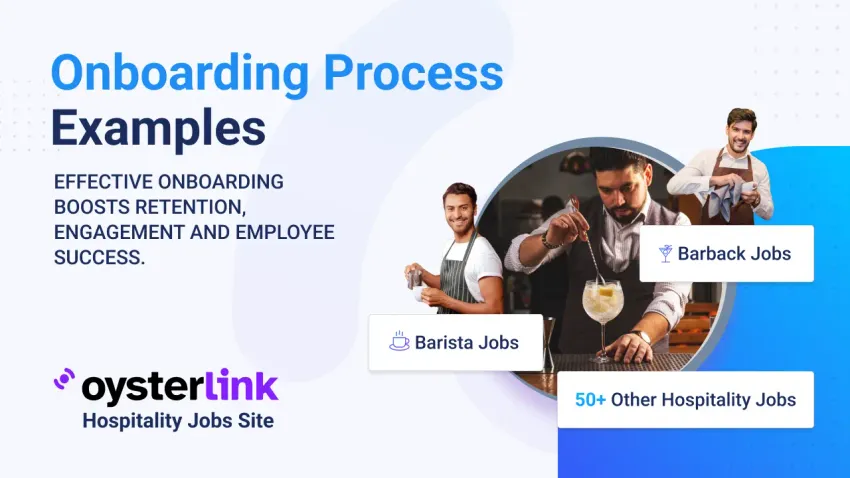
















Loading comments...